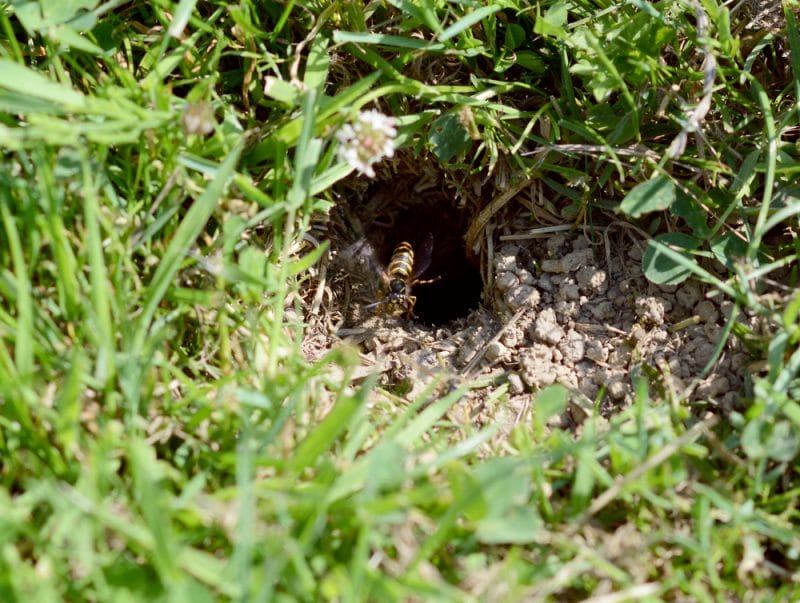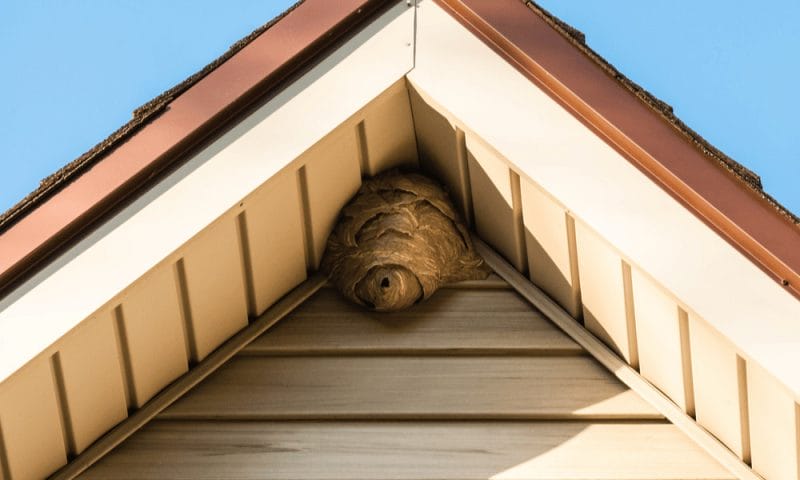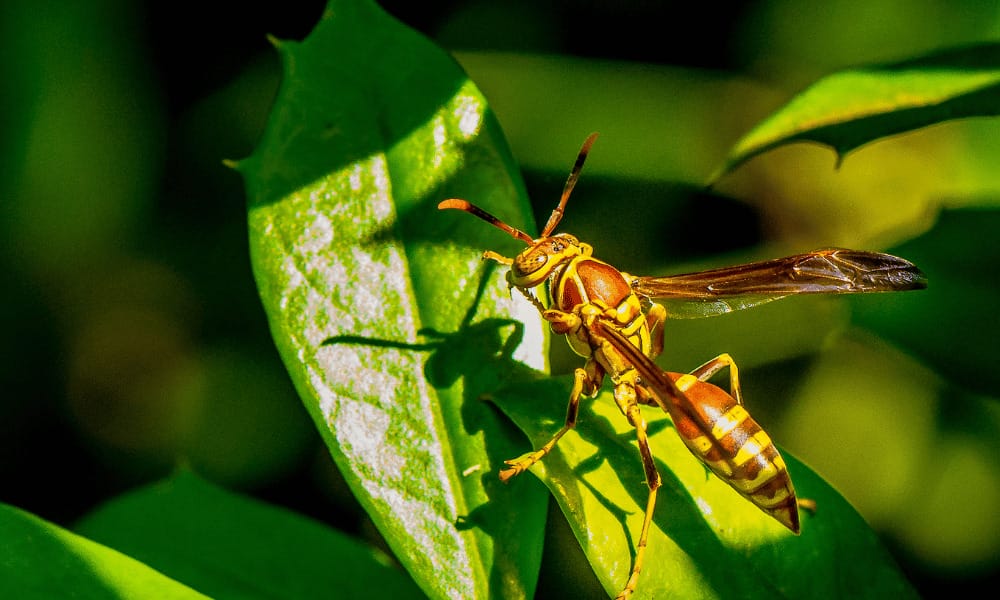
Okay, picture this: it's a beautiful summer day, the sun is shining, and you're enjoying a refreshing drink on your deck porch. Suddenly, you hear a buzzing sound and see a wasp flying around your head. Before you know it, several wasps buzz around you, turning your relaxing afternoon into a scene from a horror movie.
Don't worry; you're not alone. Wasps are a common nuisance during summer, and dealing with them can be challenging. But fear not, my friend. In this article, we'll cover everything you need to know to get rid of grass carrying wasps, yellow jackets, paper wasps, and other types of wasps. In full transparency, I'm a beekeeper, and I don't like wasps! Now that we have that out of the way.
We'll cover the best ways to identify different types of wasps, how to locate and safely remove their nests, and tips for preventing future infestations. And for those of you who prefer natural products, we've got you covered too. Plus, we'll even give you some fun facts about the wasp lifecycle. And finally, I'll also share my wacky yellow jacket childhood story, which I thought would scar me for life but I survived.
So grab a glass of ice tea, sit back, and let's learn how to get rid of those buzzing pests once and for all!
Table of Contents
Identifying Grass Carrying Wasps and Their Nests

Grass-carrying wasps, also known as Isodontia, are a species of solitary wasps that build their nests from grass blades. They are found all over the United States and can be a real problem during the spring and summer months. These wasps are not as aggressive as some other species of wasps, but their stings can still cause allergic reactions in some people.
They are generally about ½ inch long, with long legs and thin waists. They are typically black or dark brown with yellow markings. Female grass-carrying wasps use their mandibles to cut grass blades and carry them back to their nest site. They then lay their eggs in the nest and leave the larvae to feed on the grass.
Grass-carrying wasps build their nests in various locations, including on window ledges, door frames, and even in the blades of dry grass. Their nests are small, about the size of a golf ball, and are made of woven grass fibers. You may also find their nests in a hollow plant stem or wooded areas.
Types of Wasps and Their Nests
While grass-carrying wasps are one type of wasp, there are several other types that you should be aware of. Each type of wasp has its own unique characteristics and nesting habits, which can help homeowners determine the best way to deal with an infestation.
Yellow jackets, for example, are social wasps that build their nests out of paper. Their nests can be found in the ground, hollow trees, or other enclosed spaces. Yellow jackets can be aggressive, and their stings are painful, so it is important to take precautions when dealing with these wasps.
Paper wasps, on the other hand, build open, umbrella-shaped nests that hang from trees, eaves, or other structures. Their nests are made of paper-like material, which is created by mixing wood fibers and saliva. Paper wasps are generally less aggressive than yellow jackets, but their stings can still be painful.
Bald-faced hornets are another type of social wasp that builds large, football-shaped nests. Their nests can be found in trees or buildings and contain several hundred hornets. Bald-faced hornets can be very aggressive if their nest is disturbed and their stings are painful.
Mud daubers are solitary wasps that build their nests out of mud. They typically build their nests in sheltered locations such as under eaves or in attics. Unlike social wasps, mud daubers are not aggressive, and their stings are generally not painful.
Tree crickets are another type of solitary wasp that build their nests in hollow plant stems. These wasps are generally not harmful to humans; their nests can often be left alone without any negative consequences.
Regardless of the type of wasp, it is important to take proper precautions when attempting to remove a nest. Always wear protective clothing, such as long pants and sleeves, and use an insecticide spray to kill the wasps before attempting to remove the nest.
Can wasp stings cause allergic reactions?
Yes, wasp stings can cause allergic reactions in some people. If you experience symptoms such as difficulty breathing or swelling after being stung, seek medical attention immediately.
If you are allergic to wasp stings, it is best to avoid attempting to remove the nest yourself and call a professional pest control service.

Chart of Various Wasps, Aggressiveness, Nest Types, and etc.
| Type of Wasp | Nest Type | Location | Aggressiveness | Options to Get Rid of Them |
|---|---|---|---|---|
| Grass-carrying | Cocoon made of dry grass | Ground or in vegetation | Low | Use a wasp trap or insecticide dust, remove by hand |
| Yellow jacket | Paper nest | In enclosed spaces or in trees | High | Call a professional pest control service, use an aerosol spray |
| Paper wasp | Open, umbrella-shaped nest | Hanging from trees or structures | Medium | Call a professional pest control service, remove by hand |
| Bald-faced hornet | Football-shaped nest | In trees or on buildings | High | Call a professional pest control service, remove by hand |
| Mud dauber | Nest made of mud | Sheltered locations | Low | Remove by hand, leave alone if not posing a threat |
| Tree cricket | Nest in hollow plant stems | In hollow plant stems | Low | Leave alone if not posing a threat |
This table provides a quick and easy reference for homeowners to identify different types of wasps, their nesting habits, and their level of aggressiveness. Knowing what type of wasp you are dealing with can better determine the best way to deal with an infestation and take appropriate safety precautions.
Best Ways to Get Rid of Grass Carrying Wasps and Their Nests
There are several effective methods when it comes to getting rid of wasps and their nests. One of the best ways is to use a wasp trap, which lures the insects into a container filled with sweet liquid, effectively trapping them. Another option is to use insecticide dust, which can be applied directly to the nest to kill the wasps inside.
When dealing with a large nest, it is best to call a professional pest control service. They have the experience and equipment necessary to remove the nest and prevent future infestations safely.
Preventative measures to use in order to keep wasp away
Prevention is always the best way to avoid wasp infestations. Keep your garbage cans tightly closed and remove any sources of food that may attract wasps. If you have fruit trees, make sure to pick the fruit as soon as it ripens to prevent wasps from being attracted to the sweet smell.
Seal any entry points in your home, such as cracks in window frames or door frames, to prevent wasps from building nests inside. Keep your lawn mowed and remove any piles of leaves or debris that may be used as nesting sites.
Safety precautions in removing wasps
When attempting to remove a wasp nest, it is important to take proper safety precautions. Wear long pants and sleeves, and make sure to cover your head and face with a hat and goggles. Approach the nest at a safe distance and use an aerosol spray to kill the wasps before attempting to remove the nest. If you know a beekeeper, ask if you can borrow one of their suits or lend a hand.
If you are allergic to wasp stings, it is best to avoid attempting to remove the nest yourself and call a professional pest control service.

4 Stages of The Wasp Lifecycle
Understanding the lifecycle of wasps can help you better understand how to deal with an infestation. Most species of wasps go through the same basic lifecycle, which consists of four stages: egg, larva, pupa, and adult.
Stage 1 – Egg: Female wasps lay their eggs in a suitable nesting location. The nest may be made of paper, mud, or wood fibers, again, depending on the species.
Stage 2 – Larva: Once the egg hatches, the larva emerges. Larvae feed on other insects, spiders, or other prey that the adult wasps bring to the nest. During this stage, the wasp larvae are usually protected by adult wasps.
Stage 3 – Pupa: The larva eventually transforms into a pupa, which is the stage where the wasp undergoes metamorphosis into its adult form.
Stage 4 – Adult: After the metamorphosis is complete, the adult wasp emerges from the pupa. Adult wasps gather food for the nest and care for the young.
The length of each stage of the wasp lifecycle varies depending on the species and environmental conditions. For example, in some species, the entire lifecycle may be completed in just a few weeks, while in others, it may take several months.
It's important to note that some wasps, such as social wasps, live in colonies with a hierarchy and division of labor among the members. Other species, such as solitary wasps, live alone and do not have a social structure.
Understanding the wasp lifecycle allows you to take appropriate measures to prevent and control infestations. For example, removing wasp nests during the early stages of the lifecycle can help prevent the wasp population from growing and spreading.
5 Natural Products to Get Rid of Wasps
If you prefer to avoid using chemicals or pesticides, there are several natural products that you can use to get rid of wasps. Here are a few options:
- Peppermint oil: Wasps do not like the smell of peppermint oil, so spraying a solution of peppermint oil and water around your home can help to repel them. If you have a variety of oils, Great! You’re all set. If not, we recommend the bundled essential oil kit; it’s a great start.
- Vinegar: White vinegar can be used to create a solution that will deter wasps. Mix equal parts vinegar and water in a spray bottle and spray it around your home and near any wasp nests.
- Citronella oil: Similar to peppermint oil, citronella oil has a scent that wasps do not like. You can mix citronella oil with water in a spray bottle and use it to repel wasps.
- Soap and water: A simple solution of soap and water can be used to kill wasps. Mix a few drops of dish soap with water in a spray bottle and spray it directly on the wasps or their nests.
- Cinnamon: Wasps also dislike the smell of cinnamon. You can sprinkle cinnamon around your home or near wasp nests to repel them.
While these natural products can be effective in repelling or killing wasps, it is important to note that they may not be as effective as chemical pesticides. Additionally, these products may need to be reapplied more frequently than chemical products. Always take necessary safety precautions when dealing with wasps, even if you are using natural products. I have family members who only use soap and water and have had fabulous success with this method.
My Wacky Yellowjacket Childhood Story (Run Forest, Run)
I suppose I was about 12 years old when my yellow jacket saga began. It was one of those summer days when it was my turn to cut the grass. My dad was pruning flowers, and unbeknownst to me, there was a yellow jacket ground nest in the front yard where I was cutting.
Well, one yellowjacket, let's call him “Angry Bob”, wasn't thrilled about my activity and zipped past me while stinging me at the same time. Before I knew it, he performed an about-face, charged, and stung me again.
In panic mode, I ran screaming like a girl while this monster continue chasing and stinging me, or so I thought. I eventually jumped in a neighbor's old truck that was parked in his backyard. With tears in my eyes and shaking, I turned, and near the passenger seat, the doggone thing was in the truck with me. Of course, I jumped out of the truck, still crying, and ran into the house to my mother. My dad came in and said, “oh yeah, forgot to tell you there is a yellowjacket nest near the fence line, so be careful.” Thanks, dad! I hope he reads this blog post.
Now that I'm a beekeeper, I look for pollinators, but not wasps. 7 Ways To Attract Amazing Pollinators To Your Garden
Conclusion
Grass-carrying wasps and other types of wasps can be a real problem during summer, but there are several effective ways to eliminate them. You can choose the best removal method by identifying the type of wasp and its nest. Taking preventative measures and following safety precautions can also help to prevent future infestations. Remember always to approach wasps with caution and seek professional help if necessary.
I wrote a related blog post on wasps titled: Does Pine Sol Keep Wasps Away? + Alt. Hacks
Frequently Asked Questions
What are grass-carrying wasps and are they dangerous?
Grass-carrying wasps are a type of solitary wasp that carry blades of dry grass to create a cocoon for their larvae. While they are not generally considered dangerous to humans, they can sting if provoked. If you are allergic to wasp stings, it is best to take precautions when dealing with these insects.
What is the best time of year to remove a wasp nest?
The best time of year to remove a wasp nest is in the early morning or late evening when the wasps are less active. It is also best to remove the nest in the fall after the adult wasps have died but before the following spring when new nests may be constructed.
Are all types of wasps aggressive?
No, not all types of wasps are aggressive. Solitary wasps, such as mud daubers, are generally not aggressive and their stings are not very painful. Social wasps, such as yellow jackets and bald-faced hornets, can be more aggressive and their stings can be painful.
Can wasps be beneficial?
Yes, wasps can be beneficial to the environment. Many species of wasps, such as mason bees, are important pollinators. Additionally, wasps can help to control the populations of other insects, such as caterpillars and flies.



